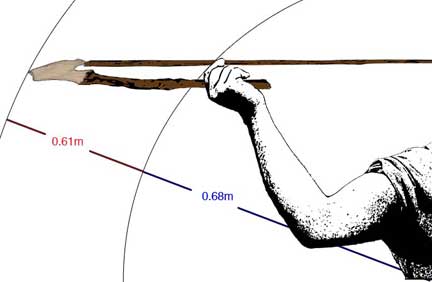|
What is an Atlatl?
The atlatl is a tool that uses leverage to achieve greater velocity and distance in throwing long flexible darts. It consists of a shaft with a handle on one end and a nock on the other, against which the butt of the dart rests. The dart is thrown by the action of
the upper arm and wrist in conjunction with a shift of balance of the body. An atlatl can launch a well made dart to ranges greater than 100 meters.The word atlatl (pronounced at-la-tal) is derived from a Nahuatl word for "water thrower", as it was most commonly used for fishing.
The atlatl is accredited with putting humans on top of the food chain. Humans have the naturally ability to throw object long distance which compensates for the fact we cannot run very fast or don’t have very sharp teeth and claws compared to other animals. The atlatl is the predecessor of the bow and arrow.
Why an Atlatl Works
When we talk about speed, we usually refer to linear velocity or the speed as an object travels in a straight line. The path of dart is not linear while it is in the thrower’s hands -- it is approximately circular. Angular velocity is the speed in a circular motion or through an angle -- its is commonly measured in radians per second. Radians are a measure of a portion of the circumference along a circle with radius of 1 unit so one revolution is 2π. The relationship between linear and angular velocities is as follows:
velocity=radius x angular velocity
v = r × ω
Distance thrown is dependent upon the speed, the angle, and the height of release of the dart. An atlatl allows a human to throw faster and further by “extending” the throwing arm. For example, say a person with 0.68 m long arm can throw a dart at 6.5 revolutions/sec (about 34.9 rad/sec):

v = 0.68m x 13π rad/sec = 27.8 m/s =100.0 km/h
If a person uses a 2 foot atlatl (0.61m)
v= 1.29m x 13π rad/sec=52.7 m/s=190.0 km/h
Using an atlatl increases the linear speed of the dart by about 90km/h.
How to Make an Atlatl
How to Throw a Dart Using an Atlatl
Lessons for Any Level of Experience with an Atlatl
Grade 7 - Math: Shape and Space; Science: Force and Motion
Math B30 - Data Analysis
Lessons for Beginner Atlatl Users
Grade 4 - Math - Patterns & Relations; Social Studies - Heritage
Grade 5 - Math - Data Management; Social Studies - Heritage (Canada’s First Peoples)
Grade 6 - Math - Data Management; Social Studies - Interaction - Pre-contact Indigenous Peoples of the Americas (Time: pre-1500)
Grade 8 - Math - Ratio and Proportion
Grade 9 - Math - Ratio and Proportion; Social Studies - Relationships with the Environment
Grade 10 - Math 10 - Linear Equations and Inequalities; Science 10 -
Physical Science: Motion in Our World; Science 10 - Life Science: Sustainability of Ecosystems; Native Studies 10-Economies: Aboriginal Perspectives
Lessons for Atlatl Users with Some Experience
Grade 4 - Math - Patterns & Relations; Social Studies - Heritage
Grade 5 - Math - Data Management; Social Studies - Heritage (Canada’s First Peoples)
Grade 6 - Math - Data Management; Social Studies - Interaction - Pre-contact Indigenous Peoples of the Americas (Time: pre-1500)
Grade 8 - Math - Ratio and Proportion
Grade 9 - Math - Ratio and Proportion; Social Studies - Relationships with the Environment
Grade 10 - Math 10 - Linear Equations and Inequalities; Science 10 -
Physical Science: Motion in Our World; Science 10 - Life Science: Sustainability of Ecosystems; Native Studies 10-Economies: Aboriginal Perspectives
Charts to go with the lessons - also can be found within corresponding lessons.
References
|

